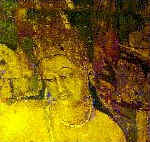|
|
|
||||||||
|
||||||||
|
||||||||
|
||||||||
|
The earliest Indic art is preserved on rocks in the paleolithic, mesolithic and neolithic stages (40000 B.C.E. onwards) and the seals and the sculpture of the Indus-Sarasvati phase which lasted from about 8000 B.C.E. to 1900 B.C.E. According to Wakankar, the beginnings of the rock art have been traced to 40,000 years BP (before present) in the decorated ostrich eggshells from Rajasthan, dated using radiocarbon techniques. Subsequent phases have been determined using evolution of style and other radiocarbon dates. The mesolithic period has been dated as 12000 to 6000 BP. It has been found that there is significant continuity of motif in the rock art and the later Indus-Sarasvati civilization indicating an unbroken link with the paleolithic and the mesolithic cultures of India. We see tessellations in the ancient rock art of India. It has been argued that these designs occur at the lowest stratum of the rock paintings and if that is accepted they belong to the upper paleolithic period. These designs are unique to India in the ancient world. Tyagi has suggested that they may represent a ``trance experience.'' The basic feature of these tessellations is infinite repetition. This repetition may occur for a basic pattern or, more abstractly, the lines extend spatially in a manner so that a basic pattern is repeated in two directions. An understanding of this abstract concept must have been a part of the thought system of the artists. This is another continuity with the central place of the notion of infinite in later Indian thought. The abstract and the iconic elements in Indian rock art are different from the more naturalistic ancient European cave paintings. There is also difference in the nature of the community and state in the Western and the Indian civilizations in the earliest urban phase. The West has monumental temples, tombs, palaces whereas the society in India appears to have been governed by a sacred order. Source: T.R.N. Rao and S. Kak Computing Science in Ancient India USL Press, Lafayette 1998. |
 |